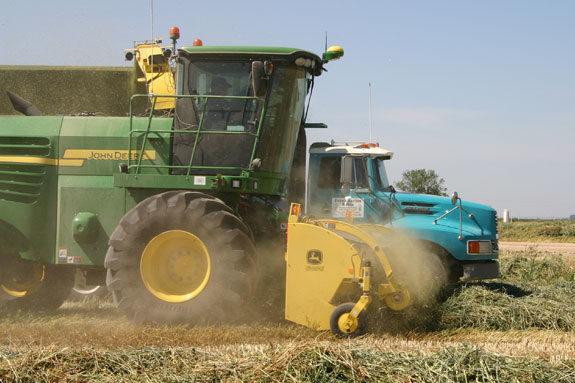A custom chopper near Chowchilla was running the show in the forage field. The irrigated Durum wheat had been cut and windrowed the previous day.
Fuel for each competing machine was measured and the chopper trucks weighed to keep track of the performances over the next three and a half hour time span.
Chopping conditions, transport trucks and all logistics were equal for both machines.
No revving engines, no burnouts and no flags, but there was suspense in the air. A newcomer was challenging the big dog on the block.
Shaun Fritchey, John Deere representative, said the point of the chopping competition wasn’t to determine who makes the best forage-chopping machine, but to examine the economics of operation.
“The point is to talk to the dairy industry about the economics of chopping forage, the fuel efficiency,” said Fritchey. “Both machines will get the job done, but there is an advantage with a machine that is more fuel efficient.”

Both machines were put on a dynamometer to measure horsepower and torque before going to the field to verify the published specifications by the manufacturers.
The results were found to be accurate. Each machine was ballasted for a 4.0 meter hay pick-up to be used in hay. The setting for length of cut for both machines was 13 mm. Three days of forage chopping ensued- along with a road transport test for fuel consumption. The same operator ran both machines to reduce differences.
In the end it was the newcomer, the John Deere 7950 that claimed an advantage in both fuel consumption and productivity over its twin-engine competitor in the friendly competition.
According to Fritchey, that JD unit average over three days was 19 ton per hour better that it’s competition. The highest tons per hour produced by the JD 7950 was 244.92 tons, compared to 216.04 tons.
There was also a 26 percent advantage in fuel consumption per ton when the two machines were compared. The fuel savings on gallon per ton basis was .04 gallon per ton.
During the road test the machines were driven the same 21.1 mile course-one using a road mode setting for engine speed management and the other turning off one of its engines. The competitive unit held a 1.1 gallon fuel advantage saving .05 gallon per mile during road transport.
Lab analysis also showed a slight advantage to the JD unit in quality of cut.
The results may not hold true in other parts of the country, Fritchey noted, but on those three days of the challenge for those two machines, it was the new kid on the block that came out ahead. FG
PHOTOS
Top: The newcomer, John Deere 7950, took home the honor of being the most fuel efficient.
BOTTO: (From left to right) Dave Thomas, Shaun Fritchey and Markus Huelpes discuss the powerful machines. Photos by Cecilia Parsons.









